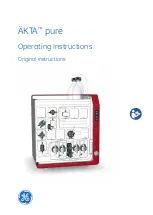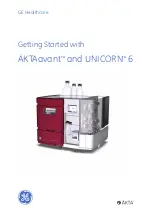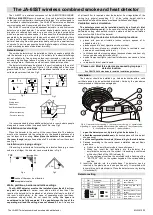
4
Notice Spécifique COMMUNE CRAMPONS réf. : T00500-B (150304)
(EN) ENGLISH
Crampons
This document contains general information on Petzl Charlet
crampons ; for the complete product information, see also the specifi c
instructions for each model of crampon.
Suitability
DART, DARTWIN, M10 : ice climbing
SARKEN: extreme mountaineering
VASAK: mountaineering, glacier travel.
IRVIS : glacier travel.
Nomenclature
(1) Front, (2) Rear, (3) Adjustment bar, (4) Rapid adjustment system,
(5) Strap, (6) DoubleBack fastening buckle, (7) Antisnow system,
(8) Wire bail, (9) Lever tab, (10) Heel bail (lever), (11) Flexible bail.
Materials:
- points: selected high performance Chrome Molybdenum steel, cold
forged and heat treated.
- wires, rivets, lever: stainless steel.
- fl exible bails: thermoplastic elastomer.
SIDELOCK binding system
- For boots with heel and toe welts in good condition.
- Heel and toe wire bails with a lateral lever binding system on the
heel wire bail plus a safety strap.
SPIRLOCK binding system
- For boots with a heel welt.
- Flexible toe harness and wire heel bail.
- Linking and fastening by a strap that restrains the action of the foot.
LEVERLOCK binding system
- Wire toe bail version for boots with heel and toe welts in good
condition.
- Flexible toe bail version for boots with a heel welt.
- Heel bail with micrometric adjustment
- Linking and fastening by a strap.
FLEXLOCK binding system
- For all semi-rigid or fl exible boots, with or without signifi cant welts.
- Flexible heel and toe harnesses that adapt to the shape of the boot
for positive fastening.
- Linking and fastening by a strap that restrains the action of the foot.
Diagram 1. Checking, points to verify
Before each use, check the attachment of the front and rear bail wires
and the rivets (SIDELOCK lever).
Check that the rapid adjustment system is correctly engaged.
Check that there are no cracks in the metal frame or points.
Diagram 2. Maintenance
To sharpen the points, fi le the edge of the point, never the side
(except for the front points). File only by hand to avoid heating which
may affect the characteristics of the steel.
After each use, clean and dry your crampons. Spray with lubricant to
avoid corrosion.
Instructions for use
Diagram 3. Position of the adjustment bar
- Observe correct positioning:
right foot/left foot, (the strap buckle should be on the outside of the
foot).
- 2 positions for the adjustment bar on the front part of the crampon:
rigid, or articulated for fl exible boots. To change between positions,
remove the screws from the front ANTISNOW, adjust the bar as
needed, then replace the screws.
WARNING for use with rigid boots check that the bar is wedged
between the stops when putting the crampon onto the boot.
Diagram 4. Adjustment
- Adjust the crampons to the length of the boot (heel positioned
against the 2 stops) using the adjustment bar (half-size increments).
For small sizes, shorten the adjustment bar with a hacksaw.
- Adjust the toe bail for the desired position of the front points: short
or long, centered or offset; and also to suit the height of the soles.
Pull back the wires using the safety straps. Check that the toe bail
wire follows the shape of the boot.
- Adjust the heel wire in the same way as the front one, for the height
of the sole and the overlap of the boot.
Install the wire by pulling on the safety strap, and check that it fi ts
securely onto the welt of the boot.
It is possible that some boots will not accept the crampons.
Diagram 5. Attachment to the boot
5A. Sidelock binding system
Attach the crampon by engaging the boot in the toe-bail and position
the heel bail by pulling on the straps. Note - to be able to position the
heel bail, be sure to push the lever down. Then pull the lever tab to
lock the heel bail in place.
Check that the wire is securely positioned in the heel welt.
Place the lever tab under the strap, fasten and tighten.
5B. Spirlock binding system
In contrast to the other systems, the heel is placed fi rst and the toe
afterwards.
Fastening using the strap: correct positioning and tightening of the
strap on the crampon ensures fi rm fastening onto the boot.
5C. Leverlock binding system
Adjust the height of the heel bail lever using the adjustment wheel.
Fastening the crampon to the boot should require effort. Do not forget
the strap.
Release the heel bail lever by using the point of an ice-axe or a pole,
as is done with ski bindings.
5D. Flexlock binding system
Fastening using the strap : correct positioning and tightening of the
strap on the crampon ensures fi rm fastening onto the boot.
Test
WARNING: Test the attachment of the crampons to the boots.
Carry out a ‘shaking’or ‘kicking’test. If the crampons seem to be
insuffi ciently secure on the boots, carry out the adjustment again to
achieve the best fi t.
Diagram 6. Attachment of antisnow systems
For your safety, the ANTISNOW system prevents snow from building
up between the points and reduces the risk of accidental slips and
falls.
WARNING: even when using an ANTISNOW system, you must always
beware of snow buildup under the crampons.
Transport
WARNING use of a storage bag (e.g. VOLUME) is advisable to protect
the points and avoid damage to other equipment.
General information
Important notice: specifi c training is essential before
use
Read this notice carefully and keep all instructions and information
on the proper use and fi eld of application of the product(s). Only
the techniques shown in the diagrams that are not crossed out
are authorized. All other uses are excluded: danger of death. A few
examples of misuse and forbidden uses are also represented (shown
in the crossed out diagrams or with the “skull and crossbones”
symbol). Many other types of misuse exist and it is impossible to
enumerate or even imagine all of them. In case of doubt or diffi culty
in understanding, contact PETZL.
Activities at height are dangerous and may lead to severe injury
or even death. Gaining an adequate apprenticeship in appropriate
techniques and methods of protection is your own responsibility.
You personally assume all risks and responsibilities for all damage,
injury or death which may occur during or following incorrect use of
our products in any manner whatsoever. If you are not able, or not in
a position to assume this responsibility or to take this risk, do not use
this equipment.
Use
This product must only be used by competent and responsible
persons, or those placed under the direct and visual control of a
competent and responsible person.
Personal protective equipment (PPE) is to be used only on or with
energy absorbing systems (for example dynamic ropes, energy
absorbers, etc). Verify that this product is compatible with the other
components of your system. See the instructions specifi c to the
products.
To prolong the life of this product, care is necessary, when
transporting as well as when using it. Avoid impacts, or rubbing
against abrasive surfaces or sharp edges.
It is up to the user to foresee situations requiring rescue in case of
diffi culties encountered while using this product.
Major fall and impact
Do not continue to use this product after a major fall or a major
impact (fall of the product or impact on the product). Even though no
external signs may be visible, a deformation may restrict its operation
or internal damage may have occurred, thus reducing its strength.
Do not hesitate to contact PETZL in case of doubt.
Checking = safety
Do not hesitate to scrap a product showing signs of wear which
might affect its strength, or restrict its operation. For your safety we
advise you to adopt a 3-level checking schedule.
- Before and after each use it is necessary to check the condition of
the product.
- During use, it is important to regularly monitor the condition of the
product and of its connections to the other elements of the system.
- A more thorough inspection must be carried out by a competent
inspector (approximately every 3 months).
For more safety and better control of your equipment, we advise you
to keep an «inspection record» for each product.
It is preferable to personally issue each user of PPE with his or her
own set of equipment.
Maximum lifetime of Petzl products: 10 years, taking
into account the development of new techniques and the
compatibility of products with other products
This lifetime depends on the intensity, the frequency of use and the
environment where the product is used.
1. In exceptional circumstances, wear or damage could occur on the
fi rst use which reduces the lifetime of the product to that one single
use.
2. Certain environmental elements will considerably accelerate wear:
salt, sand, snow, ice, moisture, chemicals, etc (list not exhaustive).
3. For sewn slings, lanyards and energy absorbers, because of their
vulnerability to wear and frequent contact with abrasive and/or cutting
surfaces (e.g. anchors), their average lifetime is 6 months intensive
use, 12 months normal use, 10 years maximum for occasional use.
Petzl recommends these products undergo an in-depth inspection
every 3 months. If the check is passed, use is approved for another
3 months.
Guarantee
This product is guaranteed for 3 years against any faults in materials
or manufacture. Exclusions from the guarantee: normal wear and
tear, oxidation, modifi cations or alterations, incorrect storage, poor
maintenance, damage due to accidents, to negligence, or to improper
or incorrect usage.
Responsibility
PETZL is not responsible for the consequences, direct, indirect or
accidental, or any other type of damage befalling or resulting from the
use of its products.





































